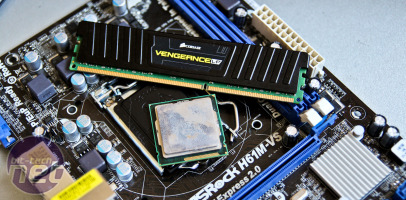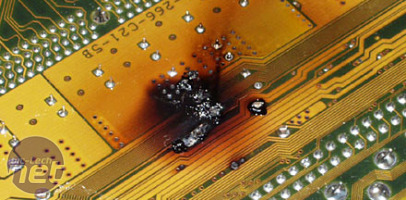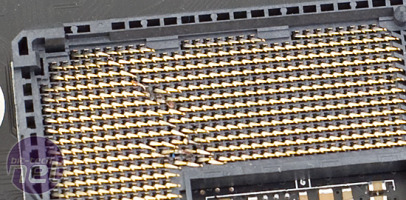What to do when hardware goes wrong
September 20, 2012 | 08:01

Anyone who's built a PC themselves or owned one for long enough has undoubtedly had moments that made them question their hobby. Random crashes, complete failure, even smoke and flames are usually part of the course as far as being a PC enthusiast goes (thankfully random crashes are rare these days, complete failure even more so and it's been years since we've smelt the sickly-sweet smell of burned silicon.)
[break]
When things go wrong, it's certainly something I consider to be a pain in the rear, but having dealt with these problems for as long as I can remember, I'm fairly confident that I'd be able to fix my PC for a lot less than it would cost to buy an entirely new one. I'm also thankful that I'm actually able to do this - we were all noobs once and fixing a PC can be particularly difficult if you don't have a lot of money to throw at it, or simply don't know where to start.
For me, having a little spare kit around is a massively encouraging thing. Should a motherboard, CPU or stick of RAM die, I could be up and running again in an hour, just by troubleshooting the issue by installing different hardware to try to isolate the problem through trial and error. Remove dead hardware, replace with new hardware, done - that kind of trouble-shooting was the first I learned.
While it does mean spending even more money on spare kit (it doesn't have to be cutting-edge, only enough to be able to swap things around to find bits that are flaky), if you're taking on the burden of keeping your PC up and running in a mission-critical situation (this is anything from doing coursework at school or university to keeping a PC used by the whole family operational) it can make life a lot easier.

My second tip is never discount a piece of hardware as being the cause of your issues. If all other possibilities have been eliminated, the answer, however improbable, will be left. For me this lesson was learned the hard way. I'd built my parents a PC and instead of going all-out on performance gear, I held back and spent a good deal on the PSU and case to make sure that power stability or cooling weren't going to cause issues.
A year later, the PC had trouble. A hard disk had been fried and the system was flaky as hell before the motherboard died too. For some reason, probably because it was a very well-known and generally well-made brand, I refused to believe the PSU was the cause of the issue and shoved a spare motherboard into the PC. A short while later I had two dead motherboards.
At this point I realised that I hadn't replaced the PSU, and it was the only item left. Sure enough, on installing a new one, the second motherboard I assumed dead actually came back to life, although the first was still dead as a doornail as was the hard disk, sadly with some unbacked up data on it. With a new PSU installed, the PC was up and running again, and it still going to this day several years later. Even if you have the best hardware, it can still go wrong without warning so never discount anything for being the cause of your problems.
Once you've identified the flaky item, the next step is to pursue a warranty claim. Building a PC is as stress free as ever today thanks to warranties from the likes of Scan that cover issues during the build process, and many companies will even replace motherboards with bent pins at no charge too. The distance selling act also means that in a vast majority of situations, you can return an item without charge within seven days of receipt for a full refund. Items that are DOA (dead on arrival) aren't uncommon either - as much as it might seem like the world is against you when your hardware arrives on a Friday ready for a weekend of building, only for a key component to be dead as a doornail, don't take this out on the retailer.
It's probably not their fault and it won't help your cause, but don't expect to be up and running instantly with a replacement either. It takes time to complete a return - if in doubt, send it back under the distance selling act (in the UK, you're able to send most online purchases back to the retailer for a full refund within 7 days or so) and buy a replacement. It will cost you more till you wait for your refund but that's they way things are, and no amount of screaming will help. Further down the line you'll be left with fewer options but if your hardware is in warranty, either with the etailer or manufacturer, then things should be straightforward.
To make things as easy as possible, it's always a good idea to keep the box for your hardware so you can send it back properly packaged or indeed sell it as 'boxed' and get more cash for your future upgrades. If you own a credit card it's also worth using this if it's of the type that offers an extended warranty on purchased items.
Another option for dealing with both troubleshooting and getting hardware replaced is to try your local PC store. We've heard of all sorts of horror stories from people using chain stores, so we'd suggest trying your local PC shop instead. Explain to them the problem, ask how they'll test it and make sure you confirm prices for everything beforehand, just like you would with a car garage. If you don't have any spare hardware, this is the only way to go the fault-finding method but it's also easier and cheaper than buying a whole PC.
Speaking of whole PCs, we all get a lot of joy out of building our own. However, you shouldn't overlook buying a complete one instead, even if you're an expert. I've reviewed many over the last couple of years that cost just a few pounds more than the individual components bought at retail prices separately, but come with the benefit of Windows being installed for you and the boon of a warranty. These can be as decent as two years on-site, meaning you shouldn't be out of action too long, and all the hassle is taken care of for you.
What tips do you have for dealing with PC troubles? Let us know in the forum.
[break]
When things go wrong, it's certainly something I consider to be a pain in the rear, but having dealt with these problems for as long as I can remember, I'm fairly confident that I'd be able to fix my PC for a lot less than it would cost to buy an entirely new one. I'm also thankful that I'm actually able to do this - we were all noobs once and fixing a PC can be particularly difficult if you don't have a lot of money to throw at it, or simply don't know where to start.
Click to enlarge
For me, having a little spare kit around is a massively encouraging thing. Should a motherboard, CPU or stick of RAM die, I could be up and running again in an hour, just by troubleshooting the issue by installing different hardware to try to isolate the problem through trial and error. Remove dead hardware, replace with new hardware, done - that kind of trouble-shooting was the first I learned.
While it does mean spending even more money on spare kit (it doesn't have to be cutting-edge, only enough to be able to swap things around to find bits that are flaky), if you're taking on the burden of keeping your PC up and running in a mission-critical situation (this is anything from doing coursework at school or university to keeping a PC used by the whole family operational) it can make life a lot easier.

Click to enlarge
My second tip is never discount a piece of hardware as being the cause of your issues. If all other possibilities have been eliminated, the answer, however improbable, will be left. For me this lesson was learned the hard way. I'd built my parents a PC and instead of going all-out on performance gear, I held back and spent a good deal on the PSU and case to make sure that power stability or cooling weren't going to cause issues.
A year later, the PC had trouble. A hard disk had been fried and the system was flaky as hell before the motherboard died too. For some reason, probably because it was a very well-known and generally well-made brand, I refused to believe the PSU was the cause of the issue and shoved a spare motherboard into the PC. A short while later I had two dead motherboards.
At this point I realised that I hadn't replaced the PSU, and it was the only item left. Sure enough, on installing a new one, the second motherboard I assumed dead actually came back to life, although the first was still dead as a doornail as was the hard disk, sadly with some unbacked up data on it. With a new PSU installed, the PC was up and running again, and it still going to this day several years later. Even if you have the best hardware, it can still go wrong without warning so never discount anything for being the cause of your problems.
Once you've identified the flaky item, the next step is to pursue a warranty claim. Building a PC is as stress free as ever today thanks to warranties from the likes of Scan that cover issues during the build process, and many companies will even replace motherboards with bent pins at no charge too. The distance selling act also means that in a vast majority of situations, you can return an item without charge within seven days of receipt for a full refund. Items that are DOA (dead on arrival) aren't uncommon either - as much as it might seem like the world is against you when your hardware arrives on a Friday ready for a weekend of building, only for a key component to be dead as a doornail, don't take this out on the retailer.
Click to enlarge - many etailers will accept returns on motherboards with bent pins
It's probably not their fault and it won't help your cause, but don't expect to be up and running instantly with a replacement either. It takes time to complete a return - if in doubt, send it back under the distance selling act (in the UK, you're able to send most online purchases back to the retailer for a full refund within 7 days or so) and buy a replacement. It will cost you more till you wait for your refund but that's they way things are, and no amount of screaming will help. Further down the line you'll be left with fewer options but if your hardware is in warranty, either with the etailer or manufacturer, then things should be straightforward.
To make things as easy as possible, it's always a good idea to keep the box for your hardware so you can send it back properly packaged or indeed sell it as 'boxed' and get more cash for your future upgrades. If you own a credit card it's also worth using this if it's of the type that offers an extended warranty on purchased items.
Another option for dealing with both troubleshooting and getting hardware replaced is to try your local PC store. We've heard of all sorts of horror stories from people using chain stores, so we'd suggest trying your local PC shop instead. Explain to them the problem, ask how they'll test it and make sure you confirm prices for everything beforehand, just like you would with a car garage. If you don't have any spare hardware, this is the only way to go the fault-finding method but it's also easier and cheaper than buying a whole PC.
Speaking of whole PCs, we all get a lot of joy out of building our own. However, you shouldn't overlook buying a complete one instead, even if you're an expert. I've reviewed many over the last couple of years that cost just a few pounds more than the individual components bought at retail prices separately, but come with the benefit of Windows being installed for you and the boon of a warranty. These can be as decent as two years on-site, meaning you shouldn't be out of action too long, and all the hassle is taken care of for you.
What tips do you have for dealing with PC troubles? Let us know in the forum.

MSI MPG Velox 100R Chassis Review
October 14 2021 | 15:04







Want to comment? Please log in.